Page 2 of 2. Go to Page 1
General Performance
The only potential bottleneck here is the 500GB hard drive which, once again makes this configuration of Inspiron 15Z slightly out of balance because the Nvidia GT630M graphics is quite a nice offering in terms of performance graphics. A Core i5 with 8GB will be no problem for general work. The HDD is connected with Intel Smart Response RAID technology and in the past we’ve found this to be one of the better hybrid solutions. We could only find an 8GB flash drive though so we hope it’s enough for long-term speedup. The specifications talk of 32GB mSATA SSD.
Audio Performance
What a great set of built-in speakers. We said that for the ASUS Taichi 21 but we’ll say it again for this Skullcandy set-up which is nice and loud, nice and clear. It’s not HiFi of course but it’s enjoyable for DVD playback, music and gaming. Headset output gives you an analogue signal and the HDMI output offers the digital audio signal.
Video (external)
The Dell Inspiron offers HDMI and WiDi video outputs but there’s no DisplayPort or VGA output. Note the touchscreen issue we reported above.
Video (Internal GPU)
We don’t often get to test discreet graphics in Ultrabooks so it’s been a bit of a learning exercise to find the advantages, limits and issues. Clearly the advantage is a much higher 3G graphics performance for gaming, a GPGPU advantage given supporting applications and the potential for other advantages like higher-resolution output. Unfortunately, with only an HDMI output, the output resolution is limited.
If you don’t need the discreet graphics (for example if you’re looking for the longest battery life) than you can disable the Nvidia graphics and you’re left with the reasonable and efficient HD 4000 GPU. For most people it’s enough until you get into gaming.
In terms of synthetic scores, you’ll see those below. In terms of real-world differences you’ll need to be doing specific tasks before you see the advantage. Design and gaming come to mind as potential benefactors but there’s always the question of whether it’s really enough. The NVidia GT630M may be powerful but it’s not running next a quad-core 3.0Ghz CPU, a part of the PC that’s also called-on to act quickly in these scenarios.
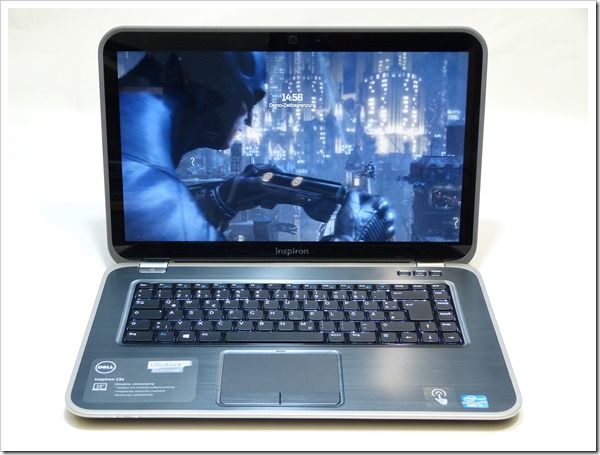
Casual PC gaming appears to work well. We tested Batman Arkham City and got fluid gameplay and impressive graphics on default settings. We tested Just Cause 2 (demo) though and got an error until we locked the GPU to the HD 4000 (where the GPU isn’t powerful enough anyway.) As for other demanding 3D operations, we just don’t think there’s enough here to make it worthwhile. Some scenarios still require tower PCs or dedicated gaming laptops with huge batteries and higher-power CPU s and GPUs.
We saw a Microsoft Visual C++ Runtime error when we tried to update the Nvidia drivers through the Nvidia tool. This is the same rundll32.exe error as we saw when we tried Just Case 2 with the Nvidia GT630M enabled.

We measured the battery drain during Batman Arkham City and it averaged 34Wh. Expect less than 90 minutes of battery-only gaming and if you’re using the device on your lap, a very warm experience. It brings us back, once again, to the portable desktop scenario where the Dell Inspiron 15Z is mainly tethered to power and an external screen and has enough GPU overhead simply to makes sure mainstream operations and casual games run smoothly.
Note that Dell includes a Cyberlink DVD player (Media Suite 10) so you don’t have to buy the Microsoft MPEG-2 license for Media Player.
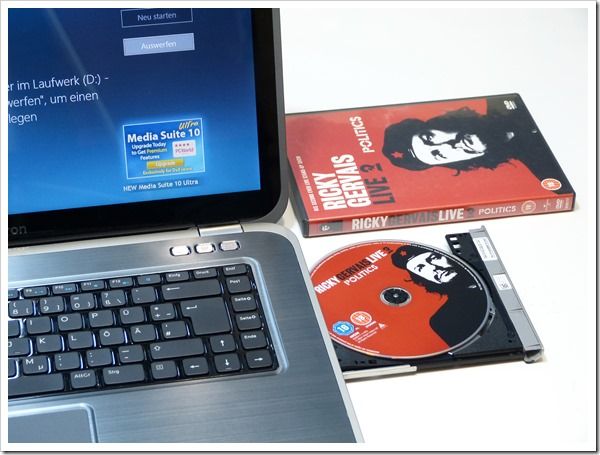
Performance Tests
All performance test done under ‘balanced’ battery power mode unless stated. SB= Sandy Bridge 2nd generation Intel Core CPU with HD 3000 graphics.
CrystalDiskMark
There’s a clear bottleneck shown in the disk performance reports.
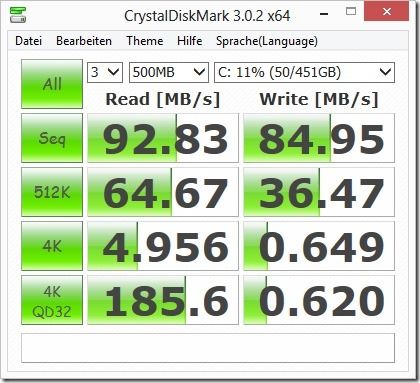
The low hard drive speed is noticeable when, for example, copying files and starting up applications for the first time. The SSD cache does help in some situations, e.g, startup of PC and commonly used programs but it’s not the complete solution for a fast storage system. On the plus side you’ve got lots of storage space. We did not try and access the mainboard to see if the SSD was upgradeable or if the HDD is easily swapped.
3DMark 06
3DMark 06 – Dell Inspiron 15Z (Core i5, GT630M) – 7772

Previous results:
- ASUS Taichi 21 (Core i5, 128GB SSD, balance battery mode) – 4658
- Dell XPS 12 (Core i7 at 1280×800) 3DMark = 4837
- Lenovo Ideapad Yoga 13 (Core i7) = 4506
- Lenovo Thinkpad Twist (Core i5, mains power – balanced performance mode @ 1280×768 resolution) = 4023
- Lenovo ThinkPad X1 Carbon (Core i7 at 1280×800) = 5224
- Samsung Series 9 2012 15” (Core i5 3317U, balanced battery mode) = 5112
- Lenovo U300S (Core i7 SB 1.7Ghz) high performance battery power: 3520, mains power: 3611
- Samsung Series 5 (Core i5 SB 1.6Ghz) Battery power – high performance mode: 3416
PCMark 7
PCMark 7 – Dell Inspiron 15Z (Core i5, GT630M) – 2642

Previous Results
- ASUS Taichi 21 (Core i5, 128GB SSD, balance battery mode) – 4522
- Dell XPS 12 (Core i7) PCMark7 = 4895
- Lenovo Ideapad Yoga 13 (Core i7) = 4615
- Lenovo Thinkpad Twist (Core i5, mains power – balanced mode) = 3386
- Lenovo ThinkPad X1 Carbon (Core i7) = 4832
- Samsung Series 9 2012 15” (Core i5 3317U, balanced battery mode) = 3129
- Lenovo U300s (Core i7 SB, 1.8Ghz) PCMark 3280
- Samsung Series 5 (Core i5 SB, 1.6Ghz) PCMark: 1894 (high performance, battery power.)
Note: The PCMark 7 score is very low. The hard disk will have contributed to this but we’re surprised that it’s this low. We confirmed that the Nvidia GPU is running and ran the test a second time with a similar result. Expected score was around 3300.
Cinebench 11.5 CPU Test (2 Core)
Dell Inspiron 15Z Cinebench CPU test – 2.33
Previous results
- ASUS Taichi 21 (Core i5, 128GB SSD, balance battery mode) – 2.24
- Dell XPS 12 (Core i7) = 2.7
- Lenovo Ideapad Yoga 13 (Core i7) = 2.23
- Lenovo Thinkpad Twist (Core i5) = 2.34
- Lenovo Thinkpad X1 Carbon(Core i7) = 2.55
- Samsung Series 9 2012 15” (Core i5 3317U, balanced battery mode) = 1.68
- Lenovo U300S (Core i7 SB): 2.12 points
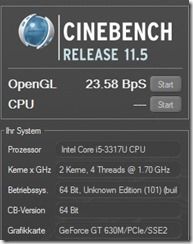
Cinebench 11.5 OpenGL
Cinebench 11.5 OpenGL Dell Inspiron 15Z (GT630M) – 23.58
Previous results
- ASUS Taichi 21 (Core i5, 128GB SSD, balance battery mode) – 14.22
- Dell XPS 12 (Core i7) = 15.23
- Lenovo Yoga 13 (Core i7) = 13.44
- Lenovo Thinkpad Twist (Core i5) – 10.73
- Lenovo Thinkpad X1 Carbon (Core i7, battery balanced) = 13.73
- Lenovo ThinkPad X1 Carbon (Core i7, mains, max performance) = 15.03
- Samsung Series 9 2012 15” (Core i5 3317U, balanced mains mode) = 15.63
- Lenovo U300s (Core i7 SB 1.7Ghz) high performance mode : 8.68
Clearly there’s a big improvement in Cinebench OpenGL scores here. With the HD4000 graphics we would expect around 15FPS so there’s a 50% improvement attributable to the Nvidia GT630M.
Battery Life
Battery life on the Dell Inspiron 15Z is generally not that good. A 44Wh battery is average for a small-screen, integrated graphics Ultrabook but for one with an additional graphics card and a 15” screen it’s not enough to make the 15Z mobile. Given that the 15Z has an optical drive, spinning hard drive and a relatively heavy weight though, it would be rather silly to put a 60Wh hr battery in this and make it even heavier, for little advantage. A removable DVD and battery slice might have been an option (the Medion S4216 has this) but again, would it bring a real advantage? The Dell Inspiron 15Z is a laptop that will primarily stay on a desk. It’s a portable desktop.
Viewed in this light, the Dell Inspiron 15Z has a large set of potential customers, but also a huge set of competitors. Touch would have been a nice option in extended mode but given the incorrect touchscreen mapping we experienced in the testing, it’s unusable in this mode.
We gave a thought to students but the weight and battery life will be prohibitive for some although if there’s a requirement for a DVD/CDROM, the Dell might fit – we did manage to see the equivalent of over 4hrs battery life under power-save, low brightness web-wordprocessing conditions but that’s not as efficient as many other Ultrabooks.
Here are a few scenario battery life figures to consider
- Offline typing – Screen low, battery saving mode, WiFi off. 6-7W for about 6.5hrs of typing.
- Online typing – As above but with WiFi on, typing in Google docs. 9.5W for about 4.5hrs of in-browser typing
- DVD playback – No Wifi, 50% screen, 50% volume. 13-14W for about 3.5hrs playback. Note: This is a nice scenario but because of non-IPS display, only suitable for one person. The DVD can be heard spinning too.
- Gaming – full power, online, high volume and screen brightness about 38W for 75 minutes of battery life
- For office work we estimate a battery life of around 3.5hrs, maybe 4 if you’re using an external monitor exclusively.
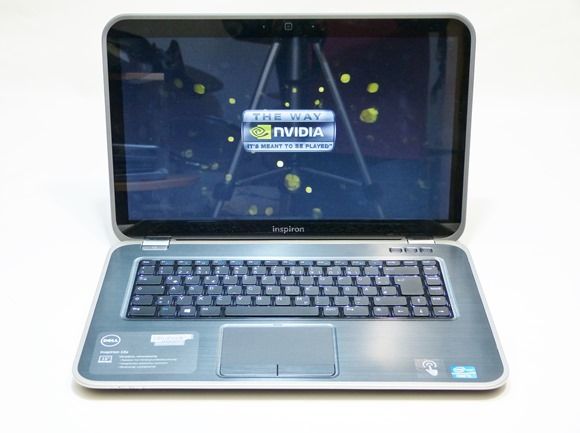
Target Customer
“Bring your media everywhere” says Dell and we would tend to agree although we’d add that you shouldn’t plan to move around too much. The Inspiron 15Z could appeal to families who want to replace a desktop or older family laptop. DVD support is important for families and with the Nvidia GT630M option you’ve got a nice setup for a bit of gaming. The backlit keyboard and mousepad are good for productivity and all the ports you’d expect are available. There are enough USB ports for printer, mice, USB stick and an external hard drive.
We have considered the student use case and for those happy to carry around a 5lb setup it’s OK although you’ll probably find other, non-Ultrabook options. The touchscreen is fun and with the speakers and CD player, you’ve got a reasonable jukebox, right out of the box for any dorm room.
Summary
Is the Dell Inspiron 15Z an Ultrabook? From our perspective it’s not very mobile, has relatively short battery life and could do with an SSD but seen from the 15-inch laptop perspective there’s an attractive package here. Only the screen disappoints in that respect and that might not be a problem for those planning to work using an external screen. We truly enjoyed the A/V capabilities of the 15Z – there’s nothing quite as easy as throwing your favorite DVD onto this and kicking back – as long as it’s only you. An IPS screen could have widened, literally, the viewer opportunity.
At $599 entry-level (Core i3, HD4000) the 15Z is still good for a lot of entertainment and productivity. The GT630M takes the gaming up a big notch so look out for offers on that. As for the touch element, we don’t feel it fits well here. If you see a good offer go for it because it’s fun and productive but if you’re planning to use an external screen, the value goes down.
Everything on the Dell Inspiron 15Z works as it should so we have no complaints from the quality aspect. It looks OK and seems to be reasonable value so if fits your requirement for a portable entertainment system, put it on your list and compare it with 5lb laptops.
[embedsite height=740px src=http://ultrabooknews.com/pullin/productdetails-pullin-generic.php?id=991]
Pages: 1 2











Looks good on paper spec wise until you get to the screen. 1366×768 displays are pretty worthless outside of clovertrail tablets to start with but a 15″ at that resolution is pointless.
The extended screen issues make this even more worthless, as its the only way to get more screen space and you effectively lose touch in the process.
Looks like im still waiting for a 1080p, 8gb, ssd, dedicated graphics machine.